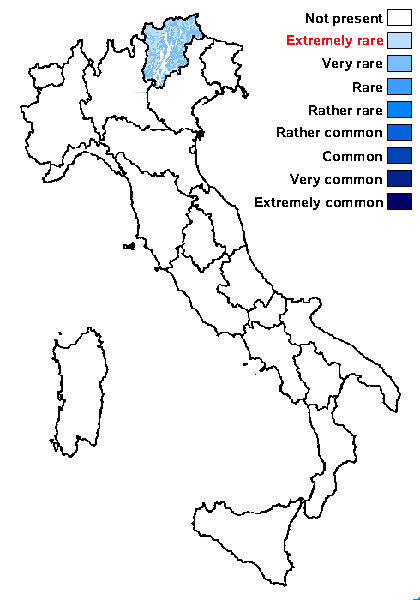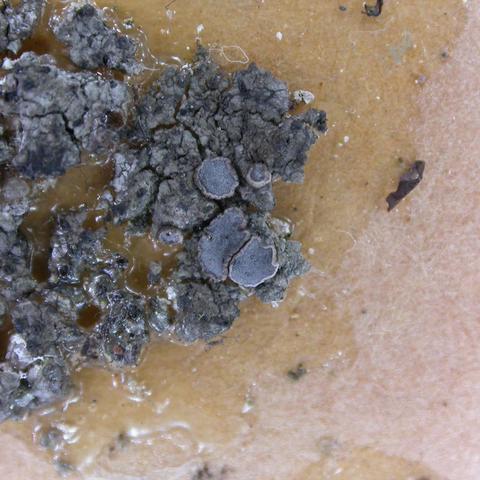Fuscidea austera (Nyl.) P. James
in Hawksworth & al., Lichenologist, 12: 106, 1980. Basionym: Lecanora austera Nyl. - Flora, 57: 309, 1874.
Synonyms: Fuscidea aggregata (Flot.) V. Wirth & Vězda; Fuscidea aggregatilis (Grummann) V. Wirth & Vězda; Fuscidea taeniarum (Malme) V. Wirth & Vězda; Lecidea aggregata (Flot.) H. Magn. non Chevall.; Lecidea aggregatilis Grummann
Distribution: N - TAA.
Description: Thallus crustose, episubstratic, continuous to rimose, pale grey to grey-brown, often delimited by a black prothallus, the areoles 0.2-0.4(-0.5) mm wide, contiguous, thin, slightly to strongly convex. Medulla I-. Apothecia lecideine, 0.5-2 mm across, often gathered in up to 3 mm wide clusters, sessile, at first rounded but soon very irregular in outline, with a black-brown, flat, sometimes thinly pruinose disc, and a usually slightly paler, persistent, strongly wavy proper margin. Proper exciple brown in outer part, paler within; epithecium brown; hymenium colourless or pale brown in upper part, 55-75 μm high; paraphyses weakly coherent, simple or sparingly branched in upper part, 1.5-2 μm thick at mid-level, the apical cell clavate, to 4 μm wide; hypothecium colourless. Asci 8-spored, clavate, with a thin external and internal K/I+ dark blue cap surrounded by a thick K/I+ pale blue apical cap, and with a K/I- apical tube in tholus, Fuscidea-type. Ascospores 1-celled, hyaline broadly ellipsoid to subglobose, (6-)9-12(-13) x 6.5-9 μm. Pycnidia black-brown in upper part. Photobiont chlorococcoid. Spot tests: thallus K-, C-, KC-, P-, UV-; apothecia UV+ bluish white. Chemistry: thallus without lichen substances; apothecia with divaricatic acid.Note: on steeply inclined to rain-sheltered surfaces of hard siliceous rocks in upland areas; in Italy hitherto reported only from South Tyrol.
Growth form: Crustose
Substrata: rocks
Photobiont: green algae other than Trentepohlia
Reproductive strategy: mainly sexual
In underhangs rarely wetted by rain
Commonnes-rarity: (info)
Alpine belt: extremely rare
Subalpine belt: very rare
Oromediterranean belt: absent
Montane belt: very rare
Submediterranean belt: absent
Padanian area: absent
Humid submediterranean belt: absent
Humid mediterranean belt: absent
Dry mediterranean belt: absent

Predictive model
Growth form: Crustose
Substrata: rocks
Photobiont: green algae other than Trentepohlia
Reproductive strategy: mainly sexual
In underhangs rarely wetted by rain
Commonnes-rarity: (info)
Alpine belt: extremely rare
Subalpine belt: very rare
Oromediterranean belt: absent
Montane belt: very rare
Submediterranean belt: absent
Padanian area: absent
Humid submediterranean belt: absent
Humid mediterranean belt: absent
Dry mediterranean belt: absent

Predictive model
 INDEX FUNGORUM
INDEX FUNGORUM
 GBIF
GBIF
 DOLICHENS
DOLICHENS


